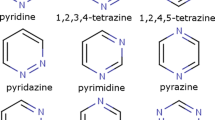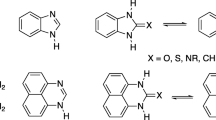Abstract
The resonance energy of amides (lactams) is calculated both with and without inclusion of the inversion barrier of model amines. Inclusion of the barrier yields a larger resonance energy for amides than for esters, whereas the reverse is true if the barrier is not included. This is consistent with intuitive views related to electronegativity. The high inversion barrier in aziridine and a lower intrinsic resonance stabilization in aziridinone explain nonplanar geometry at nitrogen in alpha-lactams. A surprisingly good correlation is seen when one plots the difference in carbonyl frequencies of strained lactams (amides) and ketones versus the enthalpy differences between two olefin analogues to the corresponding lactam (amide) resonance contributors. This correlation implies the need to invoke resonance arguments to understand strained lactams. The deviation of aziridinone from the correlation is explicable in terms of its nonplanar structure and its deviation from planarity.
Similar content being viewed by others
References
Liebman, J. F.; Greenberg, A.Biophys. Chem.,1974,1, 222.
These values are put into the context of other acyl derivatives by George, P.; Bock, C. W.; Trachtman, M. InMolecular Structure and Energetics: Biophysical Aspects; Liebman, J. F.; Greenberg, A., Eds.; VCH Publishers: New York, 1988.
Standard gas-phase enthalpies of formation obtained from Pedley, J. B.; Naylor, R. D.; Kirby, S. P.Thermochemical Data of Organic Compounds, 2nd ed. Chapman and Hall: London, 1986.
The gas-phase enthalpy of formation forN,N-dimethylacetamide is obtained by combining the liquid-phase enthalpy of formation (see ref. [4]) with the recommended enthalpy of vaporization (Majer, V.; Svoboda, V.Vaporization of Organic Compounds; IUPAC Chemical Data Series, No. 32; Blackwell Scientific Publications: Boston, 1985.
Greenberg, A. InStructure and Reactivity. Liebman, J. F.; Greenberg, A., Eds.; VCH Publishers: New York, 1988.
Rauk, A.; Allen, L. C.; Mislow, K.Angew. Chem. Int. Ed. Engl.,1970,9, 400;
Lambert, J. B.Top. Stereochem.,1971,6, 19;
Dutler, R.; Rauk, A.; Sorensen, T. S.;J. Am. Chem. Soc.,1987,109, 6290.
Greene, F. D.; Stowell, J. C.; Bergmark, W. R.J. Org. Chem.,34, 2254.
Wang, A. H.-J.; Paul, I. C.; Talaty, E. R.; Dupuy, A. E., Jr.J. Chem. Soc., Chem. Commun.,1972,43.
Treschanke, L.; Rademacher, P.J. Mol. Struct. (Theochem.),1985,122, 35.
Thomas, T. D. Unpublished results, personal communication.
Greenberg, A.; Liebman, J. F.Strained Organic Molecules. Academic Press: New York, 1978.
Woodward, R. B.; Neuberger, A.; Trenner, N. R.; InThe Chemistry of Penicillin. Clarke, H. T.; Johnson, J. R.; Robinson, R.; Eds.; Princeton University Press: 1949, pp. 415–439.
Marstokk, K.-M.; Mollendal, H.; Samdal, S.; Uggerud, E.Acta Chem. Scand.,1989,43, 351.
Yang, Q.-C.; Seiler, P.; Dunitz, J. D.Acta Crystallogr., Sect. C,1987,43, 565.
Brown, H. C.; Tsukamoto, A.J. Am. Chem. Soc.,1961,83, 4549.
For a compilation containing results of thousands of ab initio molecular orbital calculations see Whiteside, R. A.; Frisch, M. J.; Pople, J. A.The Carnegie-Mellon Quantum Chemistry Archive; Carnegie-Mellon University, 3rd ed., Pittsburgh, PA,1983.
Fogarisi, G.; Pulay, P.; Torock, F.; Boggs, J. E.,J. Mol. Struct.,1979,57, 259
Boggs, J. E.; Niu, Z.J. Comput. Chem.,1985,6, 46.
Greenberg, A.; Liebman, J. F.J. Org. Chem.,1974,39, 123.
Rademacher, P.; Wurthwein, E.-U.J. Mol. Struct. (Theochem.),1986,139, 315.
Anet, F. A. L.; Osyang, J. M.J. Am. Chem. Soc.,1967,89, 352.
This is by analogy to the calculational finding that bicyclo[3.3.3]undec-1-ene is a “hyperstable” olefin; see Maier, W.-F.; Schleyer, P. v. R.J. Am. Chem. Soc.,1981,103, 1891; McEwen, A. B.; Schleyer, P. v. R.J. Am. Chem. Soc.,1986,108, 3951.
Wang, A. H.-J.; Missavage, R. J.; Byrn, S. R.; Paul, I. C.J. Am. Chem. Soc.,1972,94, 7100.
Wiberg, K. B.; Laidig, K. E.J. Am. Chem. Soc.,1987,109, 5935.
Breneman, C. M.; Wiberg, K. B.J. Comput. Chem.,1990,11, 361.
Author information
Authors and Affiliations
Additional information
Dedicated to Professor Paul von R. Schleyer on the occasion of his 60th birthday.
Rights and permissions
About this article
Cite this article
Greenberg, A., Chiu, YY., Johnson, J.L. et al. The resonance energy of amides, the structure of aziridinone, and its relationship to other strained lactams. Struct Chem 2, 117–126) (1991). https://doi.org/10.1007/BF00676622
Received:
Accepted:
Issue Date:
DOI: https://doi.org/10.1007/BF00676622




